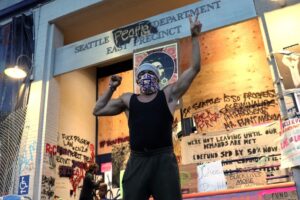The Right to Protest: What’s Included?
Are riots and autonomous zones protected by the First Amendment?
By: Jose Backer | July 1, 2020 | 524 Words

Protest at CHOP/CHAZ (Photo by Gordon ChibroskiPortland Press Herald via Getty Images)
The right to assemble is one of our most treasured civil rights. It is one of the ways that everyday citizens in the United States can make their voices heard and unified, as they gather to protest or express ideas. At the same time, this right has many restrictions. Laws on the right to assemble can vary by state and city, but generally follow the same basic guidelines.
Guidelines and Restrictions
The First Amendment directly protects citizens’ right “peaceably to assemble,” as well as the right to petition the government for change. It states:
“Congress shall make no law respecting an establishment of religion, or prohibiting the free exercise thereof; or abridging the freedom of speech, or of the press; or the right of the people peaceably to assemble, and to petition the Government for a redress of grievances.”
While America has recently seen violent protests and riots, this is not protected in the Constitution, which only allows for peaceful gatherings.
At the same time, courts have recognized the right of government to place restrictions on the time, place, and manner of peaceful assembly when it comes to the common good. In general, unlawful protests do not fall under protections granted by the First Amendment.
Case Study: The Capitol Hill Autonomous Zone (CHAZ/CHOP)

Capitol Hill Occupied Protest (CHOP) zone.(Photo by Toby Scott/SOPA Images/LightRocket via Getty Images)
In June 2020, protesters occupied a six-block area of Seattle in the Capitol Hill area. The group initially proclaimed the area CHAZ (Capital Hill Autonomous Zone), but later changed the name to CHOP (Capitol Hill Organized Protest). The protesters declared themselves independent from the city of Seattle, sparking debate as to whether this had taken the freedom of assembly too far.
Seattle Mayor Jenny Durkan and President Trump argued over whether CHAZ was a valid form of protest. Republican lawmakers introduced bills blocking federal funding to cities that allow similar occupied zones. Mayor Durkan called the occupiers “patriots” for trying to find new ways to push for police reform, while Trump said the zone had been taken over by “militant groups.” Eventually, CHAZ was cleared by the police, after a series of violent incidents in the zone.
Who Decides Our Rights?
Private property owners can set restrictions on the speech in their property.
Most cities require protest gatherings to register for permits ahead of time. Permits are not meant to be denied based on the content of the event. Unfortunately, many cities have abused this protection by denying assemblies in the name of public safety. Generally, valid reasons to stop a protest are to preserve and keep the peace, to prevent violence, and to avoid blocking traffic, businesses, emergency services and so on.
If police intend to break up a protest or assembly, they need to let the attendees know the consequences of not dispersing before they start making arrests, such as threats of arrest or less-than-lethal crowd control.
In the end, all of these protections and restrictions will be judged by the authorities, but the right to assemble still has not wavered despite this legal gray area.
















